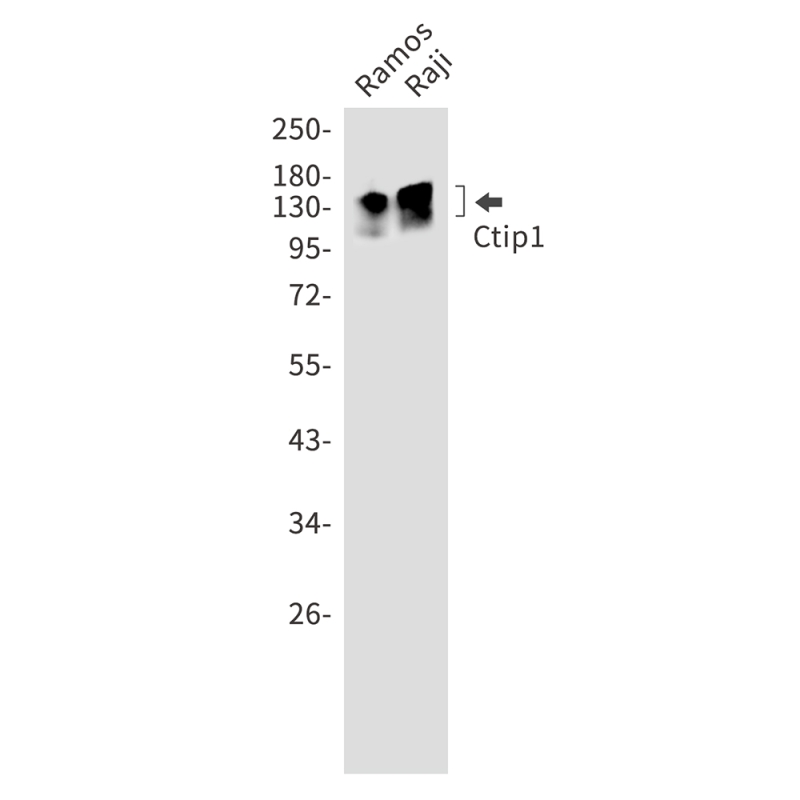
| WB | 咨询技术 | Human,Mouse,Rat |
| IF | 咨询技术 | Human,Mouse,Rat |
| IHC | 1/50-1/100 | Human,Mouse,Rat |
| ICC | 1/50-1/200 | Human,Mouse,Rat |
| FCM | 咨询技术 | Human,Mouse,Rat |
| Elisa | 咨询技术 | Human,Mouse,Rat |
| Aliases | EVI9; CTIP1; ZNF856; HBFQTL5; BCL11A-L; BCL11A-S; BCL11a-M; BCL11A-XL |
| Entrez GeneID | 53335 |
| WB Predicted band size | Calculated MW: 91 kDa; Observed MW: 100-145 kDa |
| Host/Isotype | Rabbit IgG |
| Antibody Type | Primary antibody |
| Storage | Store at 4°C short term. Aliquot and store at -20°C long term. Avoid freeze/thaw cycles. |
| Species Reactivity | Human |
| Immunogen | Recombinant protein of human Ctip1 |
| Formulation | Purified antibody in TBS with 0.05% sodium azide,0.05%BSA and 50% glycerol. |
+ +
以下是关于Ctip1抗体的3篇参考文献示例(基于公开文献信息,内容经概括整理):
---
1. **文献名称**: *"CTIP1/Bcl11a regulates cerebral cortical neuron differentiation and axonal development"*
**作者**: Leid et al.
**摘要**: 研究利用Ctip1抗体进行免疫组化和ChIP-seq分析,揭示CTIP1在哺乳动物大脑皮层神经元分化中的关键作用,证实其通过调控下游靶基因(如Tbr1)参与轴突形成和突触连接。
---
2. **文献名称**: *"Bcl11a/Ctip1 controls erythroid and megakaryocytic differentiation through distinct molecular pathways"*
**作者**: Sankaran et al.
**摘要**: 通过Ctip1抗体的Western blot和流式细胞术,发现CTIP1在造血干细胞中差异表达,并证明其通过结合γ-珠蛋白启动子抑制胎儿血红蛋白表达,为镰状细胞贫血治疗提供潜在靶点。
---
3. **文献名称**: *"Ctip1 and Ctip2 are required for the development of GABAergic neural circuits in the mouse cerebral cortex"*
**作者**: Arlotta et al.
**摘要**: 使用Ctip1抗体进行免疫荧光和基因敲除实验,发现CTIP1与CTIP2共同调控皮质中间神经元(GABA能)的迁移和功能,缺失导致小鼠皮层抑制性神经回路异常。
---
**备注**:以上为示例性文献摘要,实际引用时建议通过PubMed或Google Scholar检索关键词“Ctip1 antibody”或“Bcl11a antibody”获取最新研究。注意部分研究可能侧重CTIP1功能而非抗体本身应用。
Ctip1 (also known as Basonuclin-2 or BNC2) is a zinc finger-containing protein implicated in transcriptional regulation and cellular differentiation. It belongs to the basonuclin family and shares structural homology with Basonuclin-1 (BNC1), though their functions may diverge. Ctip1 is expressed in various tissues, including skin, hair follicles, and developing nervous systems, where it is thought to regulate genes involved in epithelial-mesenchymal interactions, cell proliferation, and tissue development. Studies suggest its role in maintaining epidermal homeostasis and hair follicle cycling, with potential links to skin disorders and cancers.
Ctip1 antibodies are essential tools for detecting and characterizing this protein in research. They are widely used in techniques like Western blotting, immunohistochemistry (IHC), and immunofluorescence (IF) to study Ctip1's expression patterns, subcellular localization, and interaction partners. Commercially available antibodies are typically raised against specific epitopes, such as the N-terminal or central regions of the protein, and require validation for specificity using knockout controls. Recent research has explored Ctip1's involvement in TGF-β signaling pathways and its regulatory effects on extracellular matrix components, highlighting its relevance in fibrosis and tumor microenvironment studies. These antibodies also aid in investigating Ctip1's potential role in developmental biology and disease mechanisms.
×